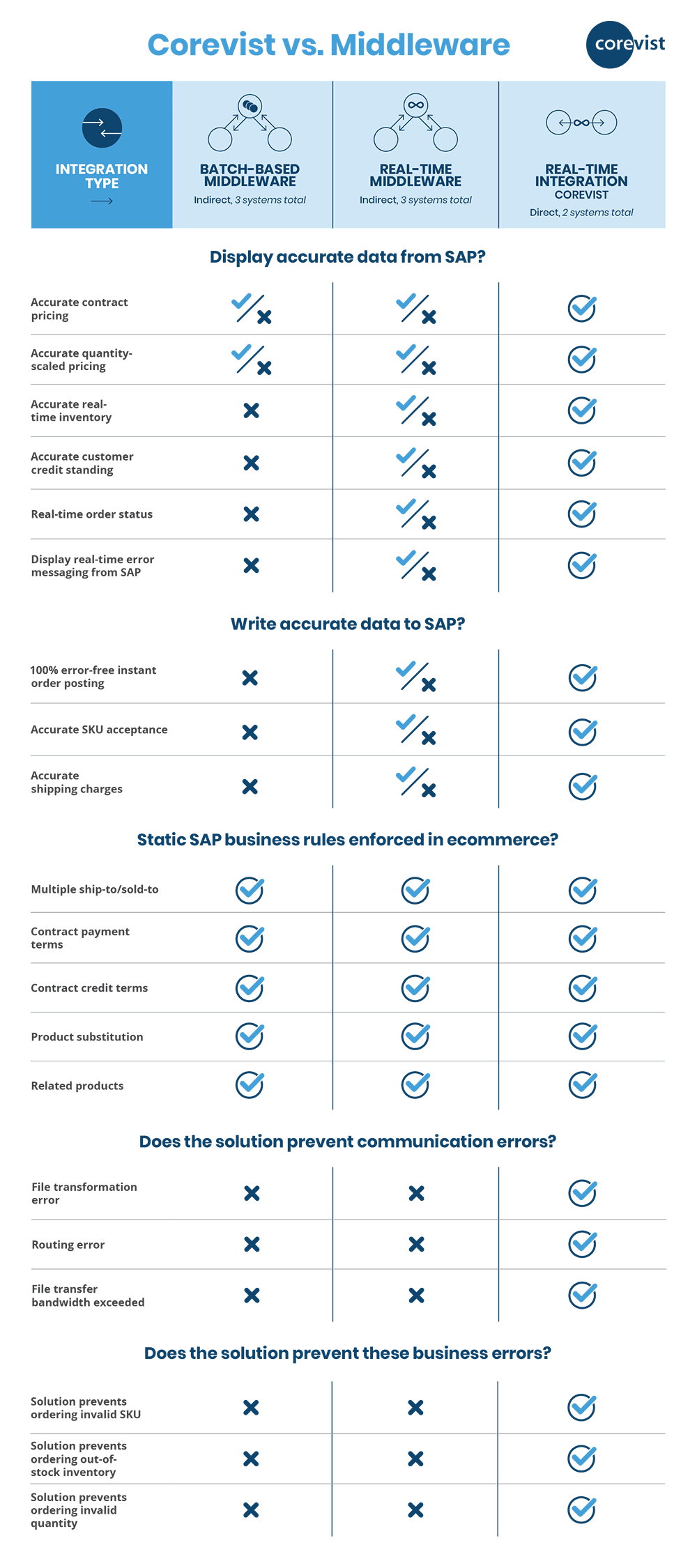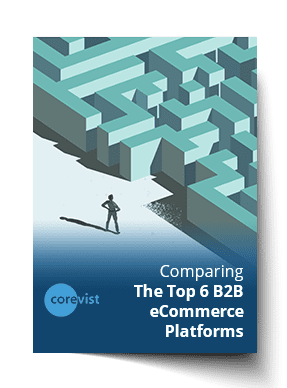Share
Author
George Anderson
Share
Originally published Apr 9, 2019. Refreshed Oct 6, 2021.
For manufacturers launching B2B eCommerce, one question looms large: how is B2B eCommerce going to interact with your SAP ERP system? Specifically, you need to determine how B2B eCommerce will modify your SAP data, and how your SAP data and logic will function in B2B eCommerce.
Believe it or not, when it comes to answering this question, there are only two basic options for architecture.
- Direct real-time integration included (like the Corevist Platform)—Only 2 systems total: SAP and B2B eCommerce.
- Middleware solution—3 systems total: SAP, middleware, and B2B eCommerce.
In the case of middleware, there are two important sub-classes depending on when the data moves between B2B eCommerce and SAP.
- Middleware solution
- Real-time middleware solution
- Batch update middleware solution
The question of B2B eCommerce integration architecture isn’t something you can save for the end of the discovery process. Rather, you should be fully informed on what each type of solution offers before you start evaluating B2B eCommerce platforms. That way, you can choose the solution architecture that meets the needs of your customers.
FREE Chart
Compare Top 6 B2B Platforms
Find your best fit based on revenue size, complexity, and depth of SAP integration required. Compare SAP Commerce Cloud, Salesforce B2B Commerce, and more.
It’s important to sort out your options before you choose a B2B eCommerce platform, because your choice of architecture can actually impact your customer experience.
Here’s a side-by-side comparison of batch update middleware, real-time middleware, and direct real-time integration (what’s included in the Corevist Platform).

Understanding the infographic
Display accurate data from SAP?
Accurate contract pricing is fairly simple to maintain in all three types of solutions. However, when it comes to quantity-scaled pricing, the business rules get more complicated. In a middleware architecture, those pricing rules will need to be rebuilt in the middleware solution. Since we can’t say whether all middleware solutions provide this functionality (or provide it with reasonable reliability at a reasonable cost), we’ve given it a Y/N.
Everything else in this category depends on a real-time integration to SAP. Since batch-based middleware architecture doesn’t read SAP in real time, it can’t provide real-time inventory, customer credit standing, order status, or error messages from SAP.
Real-time middleware can provide it—with a caveat: because there’s a third system in play (the middleware solution), that’s one more place where things can go wrong.
Direct real-time integration, like what’s included in the Corevist Platform, will query SAP in real time. There is no middleware; rather, SAP data is displayed directly in B2B eCommerce. That means when a customer logs in and views pricing, inventory, account credit status, and more, they’re looking at live data loaded straight from SAP.
Write accurate data to SAP?
Here’s one area where batch-update middleware can’t really deliver. Obviously, this type of solution can’t post orders to SAP in real time or check for order errors. That means every order a customer places can contain errors which won’t come to your team’s attention until the batch update runs. This isn’t a significant problem for small operations (say 5 or 10 orders a day). But what about 100 orders a day–or 1000? In these cases, manual order checking and fixing doesn’t scale up well. It creates more work for the customer service reps who have to correct those errors.
You might think real-time middleware eliminates this issue. However, real-time middleware also can’t guarantee 100% error-free order posting. Since business rules must be maintained in two places (SAP and middleware), there’s a greater chance of something breaking and the three systems being unable to communicate. In that case, it doesn’t make much difference whether your middleware solution is real-time or batch.
Direct real-time integration like Corevist overcomes these issues. Because the Corevist Platform plugs directly into SAP, it queries SAP in real time for order errors. If SAP returns any errors, Corevist displays them to the B2B eCommerce user so they can fix them. In fact, the Corevist Platform won’t allow an order with errors to post to SAP.
Static SAP business rules enforced in B2B eCommerce?
Here’s one area where all three solution architectures mostly deliver. We say “mostly” because there is a caveat: Since these business rules have to be rebuilt in both kinds of middleware, any change to those business rules in SAP requires the same changes to be maintained in the middleware solution. Since middleware is a duplicate system, it means duplicate work, managing one set of business rules in two places. Before embarking down the middleware path, you should determine if that double maintenance is feasible for your IT department.
Does the solution prevent communication errors?
Here’s the fundamental flaw in any middleware architecture. With a third system sitting between SAP and B2B eCommerce, all kinds of errors become possible which simply don’t happen in a direct, real-time integration like Corevist.
Does the solution prevent business errors?
In addition to communication errors, middleware architecture also makes business errors possible. With business rules maintained in two places (middleware and SAP), there’s a greater likelihood of the systems not agreeing on business data–whether it’s customers, orders, pricing terms, inventory availability, payments, or credit status.
The takeaway
If you need comprehensive SAP integration in B2B eCommerce, you should think carefully about your architecture. A solution like the Corevist Platform ensures that every customer’s B2B eCommerce experience conforms to the relevant data and logic in SAP. For manufacturers in particular (who often have complex business rules governing every transaction), that’s essential in B2B eCommerce–and it’s difficult to establish and maintain this functionality with a middleware-based architecture.
FREE Chart
Compare Top 6 B2B Platforms
Find your best fit based on revenue size, complexity, and depth of SAP integration required. Compare SAP Commerce Cloud, Salesforce B2B Commerce, and more.









